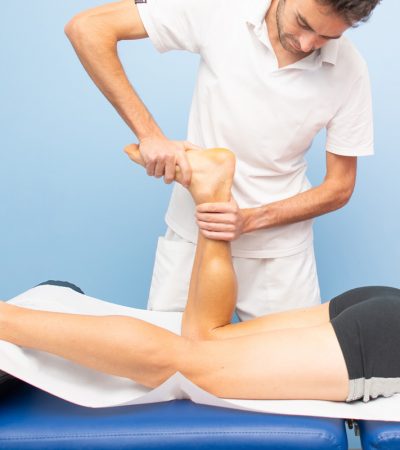What is Achilles tendonitis?
Achilles Tendonitis causes inflammation and degeneration of the Achilles tendon. The Achilles tendon is the large tendon located in the back of the leg that inserts into the heel. The pain caused bythis condition can develop gradually without a history of trauma. The pain can be a shooting pain, burning pain, or even an extremely piercing pain.This condition should not be left untreated due to the danger that the tendon can become weak and ruptured.
Achilles Tendonitis is aggravated by activities that repeatedly stress the tendon, causing inflammation. In some cases, even prolonged periods of standing can cause symptoms. It is a common problem often experienced by athletes, particularly distance runners. It is a difficult injury to treat in athletes due to their high level of activity and reluctance to stop or slow down their training. Individuals who suffer from Achilles tendonitis often complain that their first steps out of bed in the morning are extremely painful. Another common complaint is pain after steps are taken after long periods of sitting. This pain often lessens with activity.

What is Achilles tendonitis?
Achilles Tendonitis causes inflammation and degeneration of the Achilles tendon. The Achilles tendon is the large tendon located in the back of the leg that inserts into the heel. The pain caused by Achilles tendonitis can develop gradually without a history of trauma. The pain can be a shooting pain, burning pain, or even an extremely piercing pain. Achilles tendonitis should not be left untreated due to the danger that the tendon can become weak and ruptured.
Achilles Tendonitis is aggravated by activities that repeatedly stress the tendon, causing inflammation. In some cases, even prolonged periods of standing can cause symptoms. It is a common problem often experienced by athletes, particularly distance runners. Tendonitis is a difficult injury to treat in athletes due to their high level of activity and reluctance to stop or slow down their training. Individuals who suffer from tendonitis often complain that their first steps out of bed in the morning are extremely painful. Another common complaint is pain after steps are taken after long periods of sitting. This pain often lessens with activity.

Cause
There are several factors that can cause Achilles tendonitis. The most common cause is over-pronation. Over-pronation occurs in the walking process, when the arch collapses upon weight bearing, adding stress on the Achilles tendon.
Other factors that lead to Achilles tendonitis are improper shoe selection, inadequate stretching prior to engaging in athletics, a short Achilles tendon, direct trauma (injury) to the tendon, and heel bone deformity.
Cause
There are several factors that can cause Achilles tendonitis. The most common cause is over-pronation. Over-pronation occurs in the walking process, when the arch collapses upon weight bearing, adding stress on the Achilles tendon.
Other factors that lead to Achilles tendonitis are improper shoe selection, inadequate stretching prior to engaging in athletics, a short Achilles tendon, direct trauma (injury) to the tendon, and heel bone deformity.

Treatment and Prevention
Athletes, particularly runners, should incorporate a thorough stretching program to properly warm-up the muscles. They should decrease the distance of their walk or run, apply ice after the activity, and avoid any uphill climbs. Athletes should use an orthotic device, heel cup, or heel cradle for extra support.
A heel cup or heel cradle elevates the heel to reduce stress and pressure on the Achilles tendon. The device should be made with light-weight, shock-absorbing materials. An orthotic device can be used to control over-pronation, support the longitudinal arch, and reduce stress on the Achilles tendon.
Your podiatric physician/surgeon has been trained specifically and extensively in the diagnosis and treatment of all manners of foot conditions. This training encompasses all of the intricately related systems and structures of the foot and lower leg including neurological, circulatory, skin, and the musculoskeletal system, which includes bones, joints, ligaments, tendons, muscles, and nerves.
Treatment and Prevention
Athletes, particularly runners, should incorporate a thorough stretching program to properly warm-up the muscles. They should decrease the distance of their walk or run, apply ice after the activity, and avoid any uphill climbs. Athletes should use an orthotic device, heel cup, or heel cradle for extra support.
A heel cup or heel cradle elevates the heel to reduce stress and pressure on the Achilles tendon. The device should be made with light-weight, shock-absorbing materials. An orthotic device can be used to control over-pronation, support the longitudinal arch, and reduce stress on the Achilles tendon.
Your podiatric physician/surgeon has been trained specifically and extensively in the diagnosis and treatment of all manners of foot conditions. This training encompasses all of the intricately related systems and structures of the foot and lower leg including neurological, circulatory, skin, and the musculoskeletal system, which includes bones, joints, ligaments, tendons, muscles, and nerves.

